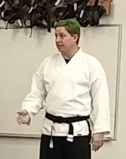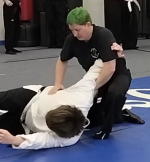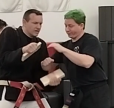Confidence, Community, and Right
- ndeplitch
- Dec 6, 2024
- 5 min read

Hey, remember me?
I took a break from the blog to focus on a few other projects. To name a few of the bigger projects, I created a 6-lesson workshop for leadership and communication which I have presented in three different forums, I earned my 3rd Degree Black Belt, and, for this site, I started a podcast! The first 6 episodes of Evolving in Toastmasters are on my YouTube channel Journey to You. Listen, like, subscribe, and hit the bell for notifications on new episodes!
In the last two years, I learned a lot about myself and the communities I serve. In this first blog back, I wanted to share some of those lessons.
And I like themes so I'm going to continue with my karate dojo's creeds. Yellow belt creed lines up perfect with my lessons on confidence and community. The creed is below:
To build true confidence through knowledge in the mind, honesty in the heart, and strength in the body.
To keep friendship with one another and to build a strong and happy community.
Never fight to achieve selfish ends, but to develop might for right.
- Jhoon Rhee
Since each line stands on its own, I feel each should get its own write up. As kind of a continuation from the White Belt creed, we get a breakdown of the three tiers of life: mind, body, and spirit with what actions for each is needed to build true confidence.
First line: “To build true confidence through knowledge in the mind, honesty in the heart, and strength in the body.”
First, your mind must be a sponge, soaking up all it can. Then, you must find a way to wring it to others in a meaningful way. When you speak about what you have learned, you find out how closely you believe it or how well you know it by how much confidence you can put behind it. Speaking about something you know well and have a strong passion for comes easy and naturally. You might have niche topics you can talk all day about. In front of a less familiar audience, your confidence might struggle out the gate but get going on the right track and it might be difficult to slow down. The important thing here is to know your subject inside and out before you present it. Repeating it out loud is a good way to imprint it or relearn it (we'll come back to this in a few creeds).
Next, with honesty in the heart, you must be true to yourself to be confident in your abilities. You may have heard the expression “the heart wants what the heart wants.” Being honest with yourself about what your heart wants will keep you from making commitments which you won’t follow through on. When it comes to confidence, the things that the heart wants will bring you confidence. It is those things that we have a strong passion which we will be excited and confident to speak about.
Lastly, confidence is evident in your body language. A strong posture is a confident one, regardless of how you initially feel on the inside. A smile on your face, even if you are faking it, will show confidence while also mind tricking yourself into acting more confidently. When speaking, your hands can enhance your speech supporting what you say if you plan movements to match your tone, mimic the descriptive words, and be comfortable with your hands at your side at lower energy points. Put it all together and you can build energy and enthusiasm through your confident body language. If you fidget, then your movements can distract your audience. Crossing your arms can display a lack of confidence in the topic. Awareness of your body and utilizing it effectively will show confidence, help you feel confident, and build true confidence in your abilities.
I made confidence one of my lessons for my leadership and communication workshop as it is one of the most important aspects for delivering a message. I gave some tips on how to improve your confidence. I’ll give away one that I talked about in episode 5 of the Evolving in Toastmasters podcast. The audience wants you to succeed. They didn’t show up to boo you or to be bored. They want YOU to educate and entertain! Understanding that before you get on stage will give you the confidence boost to smile when you step in front of them and deliver your opening.
Second line: “To keep friendship with one another and to build a strong and happy community.”
The second line is about how the dojo is a community where we help each other grow. As the saying goes, "it takes a village," it takes a community of martial artists to raise one white belt to the rank of black. And there is no waiting until black to give back to that community. It starts on day one when you commit to being a good student. A good student is a role model for others. A good student supports the teacher's lesson allowing them to build on a lesson or move ahead to the next lesson. A good student will build trust with the teacher. Each of these is a building block for the student becoming a teacher.
For my 3rd degree Black Belt, I was required to teach a course for 4 classes to other black belts. Black belts are the leaders of the dojo, encouraged to pass on what they have learned. They are learning how to be leaders outside the dojo. At 4th degree, black belts earn the privilege to open their own dojo and teach their own style. The 3rd degree project is a test of their ability to teach their own style. These projects are intended to be tied to martial arts in some way. Utilizing the workshop I developed, I choose to teach public speaking and leadership as they are essential parts of martial arts. Your voice and body language are your first line of defense. Many of the teenage black belts in the dojo lack confidence to speak in front of an audience. I felt instructing them and then giving them the floor to apply the skills would benefit them immensely. Two students who struggled at first made huge strides in their confidence and their ability to build powerful speech content. I was thoroughly impressed and proud of the impact my lessons made on the group. In the end, the workshop helped the students become better communicators and leaders for the community, but they also built closer friendships by sharing their views and stories.
Third line: “Never fight to achieve selfish ends, but to develop might for right.”
The last line is a call back to the White Belt creed last line, "Remember, it is not who is right, but what is right". Karate is for self-defense and self-discipline. It is not a weapon to wield or a tool for construction. The skills, strength, and confidence are to be used for "what is right". Of course, we are back to "what is right" being subjective and hard to define, but I find that most people can agree that honesty, fairness, and equality are right. Through karate, Toastmasters, and my personal life experiences of getting it wrong and learning what is right, I’ve developed “the might”. I have strength and courage to stand up and defend others with my voice. I have the fortitude and integrity to take responsibility for mistakes and do what is needed to make it right. Karate and Toastmasters have helped me recognize and hone my craft, but the life experiences are where the learning happens as karate and Toastmaster are just specific life experiences with curated lesson plans.
I hope this sharing has help you recognize something about yourself. Whether it is for your mind, body, or soul, whether it is about friendship or community, or whether it is discovering you have might for right, growth is valuable change you make to find yourself! This is the Journey to You!
















Comments